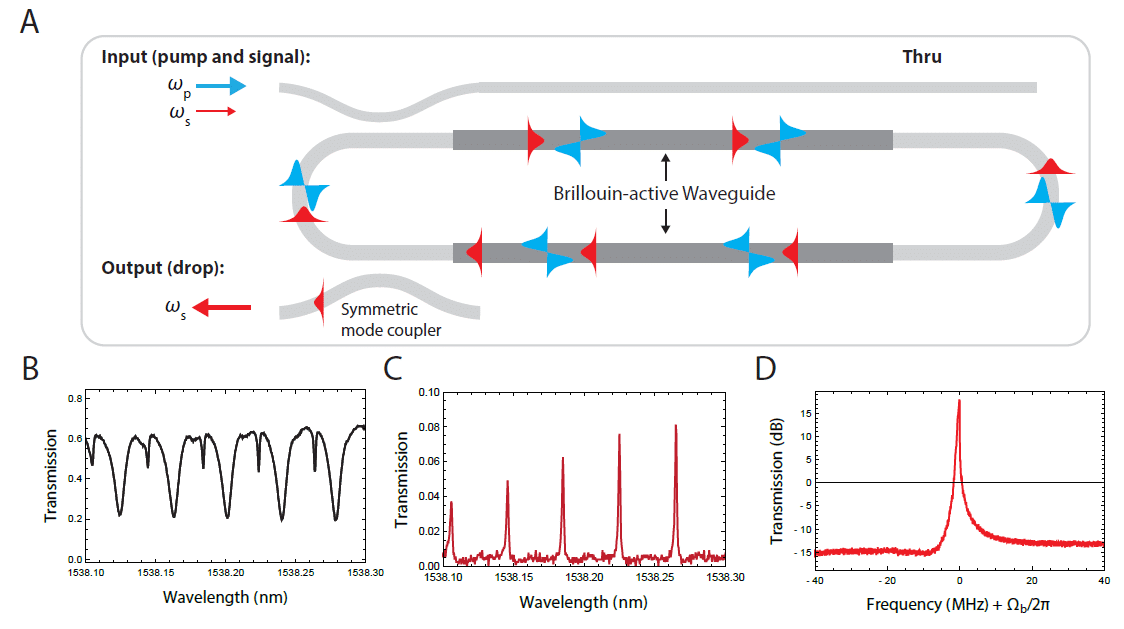
Resonantly-enhanced Brillouin Amplifier in a Silicon Photonic Circuit
2Department of Physics and Astronomy, Northern Arizona University
We achieve record-high Brillouin amplification in silicon through a resonantly-enhanced inter-modal Brillouin scattering process. These results open the door for new types of injection-locked lasers, tunable Brillouin-based filtering schemes, and distributed optomechanical phenomena.
Brillouin interactions have demonstrated great promise in the context of integrated silicon photonic amplifiers—one of the fundamental building blocks of silicon photonics [1, 2, 3]. However, achieving large Brillouin amplification in a compact footprint remains an important challenge.
Here we demonstrate high-gain Brillouin amplification in silicon by leveraging a resonantly-enhanced Brillouin interaction in an integrated silicon photonic circuit. Building on our inter-modal Brillouin laser concept [4], this resonantly-enhanced Brillouin amplifier is composed of a high-Q multimode racetrack resonator with two Brillouin-active regions (see Fig. 1A). Crucial to the device are robust mode-specific couplers, which allow us to separately interface and address the symmetric and antisymmetric cavity modes.
To operate this system as a resonantly-enhanced Brillouin amplifier, we inject pump (ωp) and signal waves (ωs=ωp-Ω) into the respective antisymmetric and symmetric modes of the racetrack resonator via a multimode coupler. We characterize the amplifier system by sweeping the detuning (Ω) of the signal wave around the Brillouin frequency (Ωb) and measuring the output signal strength at the drop port. Optimal gain is achieved when (1) the pump and signal waves meet the resonant condition for the respective antisymmetric and symmetric cavity modes and (2) the signal wave detuning matches the Brillouin frequency. Using this approach, we demonstrate more than 31 dB of gain and 18 dB of net amplification (see Fig. 1D).
These results represent more than a 500x improvement in gain and 30x improvement in net amplification relative to non-resonant waveguides of the same design [3]. Beyond this study, this device concept paves the way towards new types of injection-locked lasers, ultra-narrow-band Brillouin filters, and distributed cavity-optomechanical phenomena within integrated photonics.

Fig. 1: (A) Resonantly-enhanced Brillouin amplifier concept. (B) and (C) plot the multimode transmission spectra through the thru and drop ports. (D) Example data trace demonstrating 31 dB of gain and 18 dB of net amplification.
References
- R. Van Laer, A. Bazin, B. Kuyken, R. Baets, and D. Van Thourhout, “Net on-chip Brillouin gain based on suspended silicon nanowires,” New J. Phys. 17, 115,005 (2015).
- E. A. Kittlaus, H. Shin, and P. T. Rakich, “Large Brillouin amplification in silicon,” Nat. Photonics 10, 463 (2016).
- E. A. Kittlaus, N. T. Otterstrom, and P. T. Rakich, “On-chip inter-modal Brillouin scattering,” Nat. Commun. 8, 15,819 (2017).
- N. T. Otterstrom, R. O. Behunin, E. A. Kittlaus, Z. Wang, and P. T. Rakich, “A silicon Brillouin laser,” Science 360, 1113–1116 (2018).

Powered by Eventact EMS